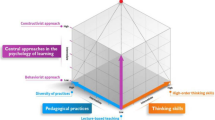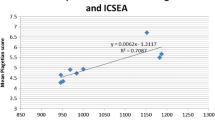Abstract
Disciplines in postsecondary education have traditionally used different models to describe the thinking processes required in their field. From a review of the models used in different disciplines, a working model of thinking processes was developed and was tested for appropriateness of fit in six pure and applied matched disciplines. The professors testing the working model applied the model to their courses in different ways and gave a variety of examples of the instructional methods they used to do this.
Similar content being viewed by others
References
Bloom, B. (Ed.). (1956). Taxonomy of educational objectives. New York: David McKay.
Brookfield, S. D. (1987). Developing critical thinking. San Francisco: Jossey-Bass.
Chi, M. T., Feltovich, P. J. and Glaser, R. (1981). ‘Categorization and representation of physics problems by experts and novices’, Cognitive Science 5, 121–152.
Cook, T. and Campbell, D. (1979). Quasi-experimentation: Design and analysis issues for field settings. Chicago, Illinois: Rand McNally.
Cronbach, L. J. (1975). ‘Beyond the two disciplines of scientific psychology’, American Psychologist 12, 671–684.
Cronbach, L. J. (1982). Designing evaluation of educational and social programs. San Francisco: Jossey-Bass.
Donald, J. G. (1985). ‘Intellectual skills in higher education’, Canadian Journal of Higher Education 15(1), 53–68.
Donald, J. G. (1986). ‘Knowledge and the university curriculum’, Higher Education 15(3), 267–282.
Donald, J. G. (1987). ‘Learning schemata: methods of representing cognitive, content and curriculum structures in higher education’, Instructional Science 16, 187–211.
Donald, J. G. (1988). ‘Professors' expectations of students' ability to think’, Higher Education Research and Development 17(1), 19–35.
Donald, J. G. and Nagy, P. (1985). The portrayal of knowledge structures: A synthesis of methods. Research report to SSHRCC. McGill University, Centre for University Teaching and Learning.
Dressel, P. L. and Mayhew, L. B. (1954). General education: Explorations in evaluation. Washington, D.C.: American Council on Education.
Dressel, P. and Mayhew, L. (1974). Higher education as a field of study. San Francisco: Jossey-Bass.
Entwistle, N. and Ramsden, P. (1983). Understanding student learning. London: Helm.
Ericksen, A. and Smith, J. (Eds.) (1991). Study of expertise: Prospects and limits. Cambridge: Cambridge University Press.
Fox, P. and LeCount, J. (1991, April). When more is less: Faculty misestimation of student learning. Paper presented at the annual meeting of the American Educational Research Association, Chicago, Illinois.
Frederiksen, N. (1984). ‘Implications of cognitive theory for instruction in problem solving’, Review of Educational Research, 54(3), 363–407.
Goldman, R. M., Schoner, P. G., and Pentony, D. E. (1980). The vocabulary of a discipline: The political science concept inventory. Santa Barbara, California: Clio Books.
Hirsch, E. D. Jr. (1967). Validity in interpretation. New Haven: Yale University Press.
Hirst, P. (1974). Knowledge and the curriculum. London: Routledge.
Holmes Group (The). (1986). Tomorrow's teachers. East Lansing: The Holmes Group, Inc.
Krathwohl, D. R. (1985). Social and behavioral science research. San Francisco: Jossey-Bass.
Kuhn, T. S. (1970). The structure of scientific revolutions. (2nd ed.). Chicago: University of Chicago Press.
Lakatos, J. and Musgrave, A. (Eds.) (1970). Criticism and the growth of knowledge. Cambridge: Cambridge University Press.
Lesgold, A. (1985, January). Psychological issues in designing expert tutors in medical education. Seminar presented by the Centre for Medical Education, McGill University.
Lincoln, Y. and Guba, E. (1985). Naturalistic inquiry. Beverley Hills: Sage Publications.
McDermott, J. and Larkin, J. H. (1978). Re-representing textbook physics problems. Proceedings of the 2nd National Conference of the Canadian Society for Computational Studies of Intelligence. Toronto: University of Toronto Press.
McKeachie, W. J. (1991, April). Faculty development: Past, present and future. Invited address to the annual meeting of the American Educational Research Association, Chicago, Illinois.
Meyer, J., Parsons, P. and Dunne, T. (1990). ‘Individual study orchestrations and their association with learning outcomes’, Higher Education 20, 67–89.
Meyers, C. (1986). Teaching students to think critically: A guide for faculty in all disciplines. San Francisco: Jossey-Bass.
Miles, M. B. and Huberman, A. M. (1984). Qualitative data analysis: A source book of new methods. Beverley Hills: Sage Publications.
Popper, K. R. (1959). The logic of scientific discovery. London: Hutchinson.
Reif, J. (1983, April). Acquiring an effective understanding of scientific concepts. Paper presented at the annual meeting of the American Educational Research Association, Montreal, Quebec.
Reif, F., Larkin, J. H. and Brackett, G. C. (1976). ‘Teaching general learning and problem-solving skills’, American Journal of Physics, 44(3), 212–217.
Ricoeur, P. (1976). Interpretation theory: discourse and the surplus of meaning. Fort Worth, Texas: The Texas Christian University Press.
Stake, R. (1967). ‘The countenance of educational evaluation’, Teachers College Record 68, 523–540.
Stake, R. (1975). Evaluating the arts in education: A responsive approach. Columbus: C. E. Merrill.
Sternberg, R. J. (1985, November). ‘Teaching critical thinking, Part 1: Are we making critical mistakes?’, Phi Delta Kappan, 194–198.
Watson, G. and Glaser, M. (1980). Watson-Glaser Critical Thinking Appraisal. New York: Harcourt, Brace and World, Inc.
Author information
Authors and Affiliations
Rights and permissions
About this article
Cite this article
Donald, J.G. The development of thinking processes in postsecondary education: Application of a working model. High Educ 24, 413–430 (1992). https://doi.org/10.1007/BF00137240
Issue Date:
DOI: https://doi.org/10.1007/BF00137240




